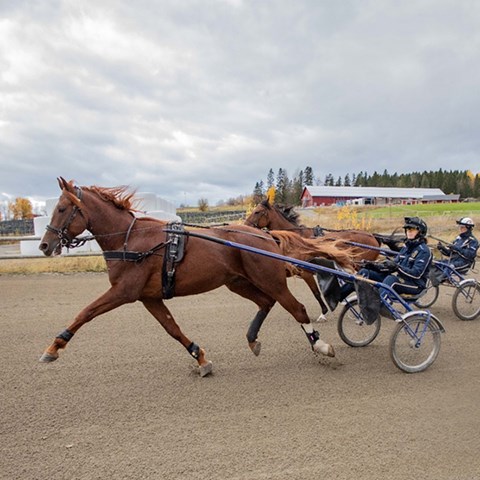New insights into rein tension and driveability associated with racetrack training of Standardbred trotters

How much power or tension is there in the reins when a trotting horse runs at full speed on the track, and should drivers trust their gut feeling? Elke Hartmann from SLU has investigated this in collaboration with researchers from Australia, Germany and Sweden. The study, which is the first of its kind, shows that significantly more tension is used on trotters than on most riding horses during trotting.
The study was recently published in the journal Applied Animal Behavior Science.
Standardbred race-trained college horses driven on their home racetrack and equipped with rein tension meters encountered on average 6 kg of rein tension during racing trot and during single occasions of up to 14 kg. This is considerably more than most riding horses are exposed to during trotting.
“Up to now we have largely relied upon drivers’ and trainers’ descriptive reports about driving horses’ responses to rein signals,” Hartmann says. “This is a surprising knowledge gap, given the large amount of objective data available on rein tension in ridden horses and the ongoing debates on the training and welfare of racehorses,” Hartmann continues.
The new research has found steering horses through the curves of an oval banked track did not disrupt an even contact with both driving reins. This finding may reflect the importance of performance and safety when driving in a tight field of other horses. Moreover, drivers could accurately report the horses’ reactions to rein signals, for example, whether or not they were leaning more on one rein than the other. That said, there was disagreement among the drivers about what to expect when driving a horse labelled as having a ‘soft mouth’. So, the label remains a subjective assessment because drivers’ evaluations were not reflected in lower rein tensions, raising the question of what constitutes optimal contact to safeguard horse welfare and drivers’ safety.
Rein tensions translate to bit pressure, which is what matters to the horses. It is paramount to measure and monitor the forces Standardbreds and other horse breeds used for harness racing are exposed to during training and competition. “We need to understand better their responses to the drivers’ signalling, drivers’ reasoning about use of equipment and possible correlations with rein tensions and incidences of mouth injuries,” Hartmann points out. “Training deficits such as habituation to rein signals and consequent loss of effective control must be avoided. And it is only objective data can make drivers aware of the rein tensions they apply. Studies such as this will also unpack the use of harsher bits as a default response to decreased controllability and thereby low driveability.”
Driveability, as compared to “rideability”, the equivalent industry term for riding horses, may involve attributes such as straightness, softness in the mouth, and horses’ responses to signals from the driver. In this study, drivers reported driveability scores on a 10-point scale (from poor to excellent) but their scores were not associated with actual rein tensions, and the scores increased the higher the drivers estimated the rein tension they were applying. This suggests that that, when estimating driveability, drivers had in mind traits other than simple low rein tension, with some considering a ‘heavier’ contact as desirable for good performance. “Clearly, our study has been a first step towards explaining the communication between driver and horse and confirmed that rein tensiometry has a place in providing an evidence-base for discussions about optimal rein use in harness racing and, ultimately, use of equipment,” Hartmann summarizes.
The study was financed by the Swedish-Norwegian Foundation for Equine Research and has been carried out at Wången, Sweden’s national centre for the education and development of harness racing and Icelandic horse riding.
Contact person
Dr Elke Hartmann
Swedish University of Agricultural Sciences
Department of Animal Environment and Health
elke.hartmann@slu.se, +46 76 832 49 00
Publication
Hartmann, E., Byström, A., Pökelmann, M., Connysson, M., Kienapfel-Henseleit, K., Karlsteen, M., & Egenvall, A. (2022). Associations between driving rein tensions and drivers’ reports of the behaviour and driveability of Standardbred trotters. Applied Animal Behaviour Science, 105726. https://doi.org/10.1016/j.applanim.2022.105726
Press image
(May be published without charge in articles about this press release, please acknowledge the photographer).
Standardbreds during the exercise test at Wången. Photo: Courtesy Kathrin Kienapfel-Henseleit